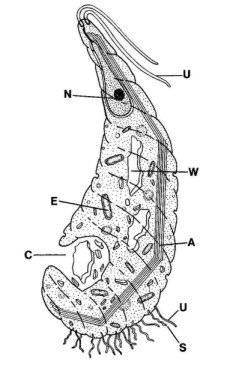Oxymonadida
Based mainly on:
Kulda, J. and Nohynkova,
E. (1978). Intestinal Flagellates. Parasitic protozoa II (Kreier, J.P.,
ed.) Academic P, Inc., New York, 2-139
Dyer, B.D. (1989). Phylum
Zoomastigina Class Pyrsonymphida. Handbook of Protoctista (Margulis,
L., ed.), Johnes and Bartlett Publishers, Boston, 266-269
This order consists of
two groups. Various authors regard them as separate taxons on different taxonomic
level and not regard them as relative groups.
Polymastigidae
The family Polymastigidae
include primitive oxymonads predominantly living in insects. members of the
genus Monocercomonoides inhabit also the intestine of vertebrates. None
of them is pathogenic. Although the occurrence of both trophozoites and cysts
appears to be a general feature in the genus Monocercomonoides, only
the trophozoite stage has been described for the majority of species. The cysts
reported in some species from insects are round, uninucleate, and have a thin
wall. Trophozoites of the genus Monocercomonoides have a round or ovoid
body equipped with four flagella arranged in two separate pairs. All flagella
are of the acroneme type , e.g., terminated by a thin filament. One or more
flagella are recurrent adhering to the body for some distance, and then continuing
in free trailing portion. Each recurrent flagellum is accompanied by a ribbon
of funis which follows and, sometimes , surmounts the adherent part of the flagellum.
Two separate groups of kinetosomes are connected by U-shaped fiber. One group
is placed dorsally, the other ventrally in the frontal part of the body. The
axostyle, joined to the dorsal group of kinetosomes, extends posteriorly where
it often projects for a short distance. Its uniform thickness throughout its
length is typical feature. The apex of the body is enveloped by a large pelta.
Beneath the pelta is a helmet-shaped body-preaxostyle-capping the anterior pole
of the nucleus. The anteriorad situated nucleus of vesicular type is round and
typically contains a large spherical endosome. Conspicuous digestive vacuoles
with food particles are numerous in the cytoplasm. Trophozoites of the genus
Monocercomonoides multiply by binary fission. No multiplication in the
cyst stage has been observed.
Pyrsonymphidae
The
pyrsonymphids are heterotrophic protists that have been found only in the hindgut
of wood-eating cock-roaches and termites. They have been placed in the separate
class pyrsonymphida by Margulis and Schwartz (1988). This group contains genera
Notilla, Oxymonas, Pyrsonympha , Saccinobaculus
etc. Pyrsonymphids are characterised by the presence of 4, 8, or 12 flagella
and motile axostyle that extends the length of the body. Hydrogenosomes and
mitochondria have not been detected in pyrsonymphids. Many bacteria including
spirochetes, can be associated with pyrsonymphids as epi- and endosymbionts.
Pyrsonymphides are of indirect practical importance by their obligate association
with their wood-destroying hosts, the dry wood and subterranean termites. Pyrsonymphids
have complicated life cycle with meiosis and gametes involved.
 Fig.
2. TEM analytical drawing of Pyrsonympha vertens . Axostyle(A), cytostome
(C), endosymbiotic bacteria (E), nucleus (N), symbiotic spirochetes (S), flagella(U),
wood particle (W). (Drawing by Christie Lyons. Reprinted from Margulis , L.
and Sagan, 1986, Origin of Sex, Yale University Press).
Fig.
2. TEM analytical drawing of Pyrsonympha vertens . Axostyle(A), cytostome
(C), endosymbiotic bacteria (E), nucleus (N), symbiotic spirochetes (S), flagella(U),
wood particle (W). (Drawing by Christie Lyons. Reprinted from Margulis , L.
and Sagan, 1986, Origin of Sex, Yale University Press).
 Fig.
2. TEM analytical drawing of Pyrsonympha vertens . Axostyle(A), cytostome
(C), endosymbiotic bacteria (E), nucleus (N), symbiotic spirochetes (S), flagella(U),
wood particle (W). (Drawing by Christie Lyons. Reprinted from Margulis , L.
and Sagan, 1986, Origin of Sex, Yale University Press).
Fig.
2. TEM analytical drawing of Pyrsonympha vertens . Axostyle(A), cytostome
(C), endosymbiotic bacteria (E), nucleus (N), symbiotic spirochetes (S), flagella(U),
wood particle (W). (Drawing by Christie Lyons. Reprinted from Margulis , L.
and Sagan, 1986, Origin of Sex, Yale University Press).